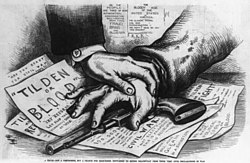Ceasefire
This article needs additional citations for verification. (January 2011) |

A ceasefire (or truce) is a temporary stoppage of a war in which each side agrees with the other to suspend aggressive actions. Ceasefires may be declared as part of a formal treaty, but they have also been called as part of an informal understanding between opposing forces. An armistice is a formal agreement to end fighting.
Historical examples
World War I
During World War I, on December 24, 1914, there was an unofficial ceasefire as France, the United Kingdom, and Germany observed Christmas. No treaty was signed, and the war resumed after a few days.
Korean War
In 29 November 1952, the newly U.S. president-elect Dwight D. Eisenhower, went to Korea to learn what might end the Korean War. With the United Nations' acceptance of India's proposed Korean War armistice, the KPA, the PVA, and the UN Command ceased fire with the battle line approximately at the 38th parallel. Upon agreeing to the ceasefire agreement, the belligerents established the Korean Demilitarized Zone (DMZ), which has since been patrolled by the KPA and ROKA, US, and Joint UN Commands. The Korean Demilitarized Zone runs northeast of the 38th parallel; to the south, it travels west. The old Korean capital city of Kaesong, site of the armistice negotiations, originally lay in the pre-war ROK, but now is in the DPRK. The United Nations Command, supported by the United States, the North Korean Korean People's Army, and the Chinese People's Volunteers, signed the Armistice Agreement on 27 July 1953 to end the fighting. The Armistice also called upon the governments of South Korea, North Korea, China and the United States to participate in continued peace talks. For his part, ROK President Rhee attacked the peace proceedings. The war is considered to have ended at this point, even though there was no peace treaty.
Vietnam War
On January 15, 1973, President Richard Nixon ordered a ceasefire of the aerial bombings in North Vietnam. The decision came after Dr Henry Kissinger, the National Security Affairs advisor to the president, returned to Washington from Paris France with a draft peace proposal. Combat missions continued in South Vietnam. By January 27, 1973, all warring parties in the Vietnam War signed a ceasefire as a prelude to the Paris Peace Accord.
Persian Gulf War
After Iraq was driven by U.S.-led coalition forces out of Kuwait during Operation Desert Storm, Iraq and the U.N. Security Council signed a ceasefire agreement on March 3, 1991. Throughout the 1990s, the U.N. Security Council passed 16 Resolutions calling for Iraq to disarm the WMDs program unconditionally and immediately. Because no peace treaty was signed after the Gulf War, the war still remains on effect like Iraqi forces firing on coalition aircraft patrolling Iraqi no-fly zones, U.S. President Bill Clinton bombing of Baghdad in 1998 during Operation Desert Fox, and a bombing of Iraq by Clinton in 1996 during Operation Desert Strike. The war remains in effect until 2003 when U.S. and UK forces invaded Iraq and toppled Saddam Hussein's Regime from power.
Kashmir conflict
Pakistan's government has repeatedly claimed that India is violating the Simla Agreement by constructing a fence along the Line of Control in the Kashmir Conflict. However, India maintains the fence has decreased armed infiltration into Indian-administered Kashmir.
Then-Pakistani President and ex-Army Chief of Staff Pervez Musharraf promised in 2002 to curb infiltration into the disputed territory.
Israeli–Palestinian conflict
An example of a ceasefire in the Israeli–Palestinian conflict was announced between Israel and the Palestinian National Authority on February 8, 2005. When announced, chief Palestinian negotiator Saeb Erekat publicly defined the ceasefire as follows: "We have agreed that today President Mahmoud Abbas will declare a full cessation of violence against Israelis anywhere and Prime Minister Ariel Sharon will declare a full cessation of violence and military activities against Palestinians anywhere."[1]
Provisional IRA – British government
Throughout the period of The Troubles, the Provisional IRA and other paramilitary groups have called ceasefires. The most notable of these being the IRA ceasefire which was called on 31 August 1994 and ended on 9 February 1996 with the Docklands bombing. Another ceasefire was declared in July 1997 after negotiations were reopened.
Spanish government – ETA
ETA has declared several ceasefires during its long running campaign against the Spanish state. A ceasefire declared in March 2006, was broken on December 30, 2006, when a car bomb exploded in Madrid killing two people.[2] On 5 September 2010 ETA declared a ceasefire.[3]
See also
References
- ^ Wedeman, Ben (2005-02-07). "Mideast cease-fire expected Tuesday". CNN. Retrieved 2007-01-03.
{{cite news}}: Unknown parameter|coauthors=ignored (|author=suggested) (help) - ^ Second Madrid blast victim found
- ^ Spain's ETA 'declares ceasefire'
